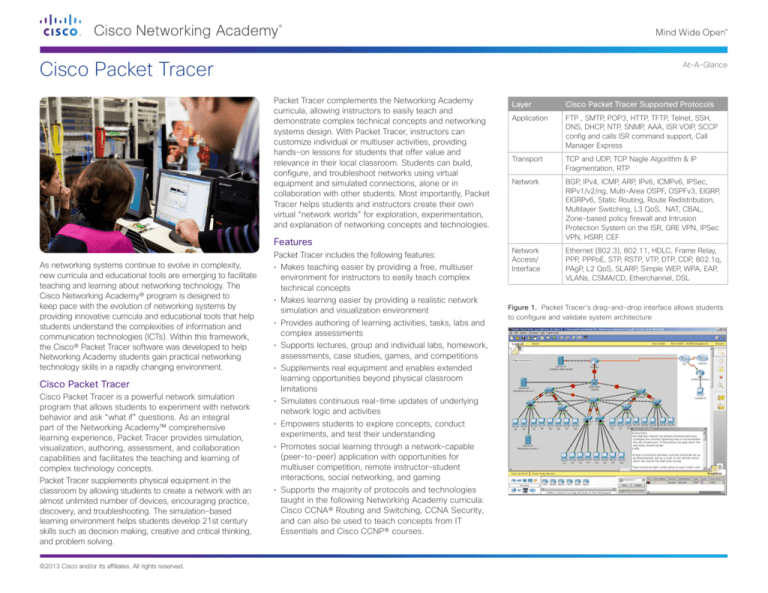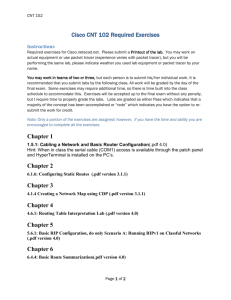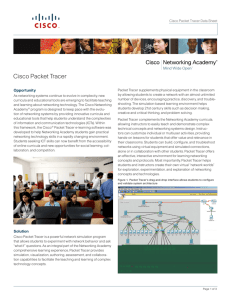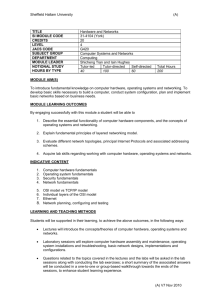
Cisco Packet Tracer
At-A-Glance
Packet Tracer complements the Networking Academy
curricula, allowing instructors to easily teach and
demonstrate complex technical concepts and networking
systems design. With Packet Tracer, instructors can
customize individual or multiuser activities, providing
hands-on lessons for students that offer value and
relevance in their local classroom. Students can build,
configure, and troubleshoot networks using virtual
equipment and simulated connections, alone or in
collaboration with other students. Most importantly, Packet
Tracer helps students and instructors create their own
virtual “network worlds” for exploration, experimentation,
and explanation of networking concepts and technologies.
Features
As networking systems continue to evolve in complexity,
new curricula and educational tools are emerging to facilitate
teaching and learning about networking technology. The
Cisco Networking Academy® program is designed to
keep pace with the evolution of networking systems by
providing innovative curricula and educational tools that help
students understand the complexities of information and
communication technologies (ICTs). Within this framework,
the Cisco® Packet Tracer software was developed to help
Networking Academy students gain practical networking
technology skills in a rapidly changing environment.
Cisco Packet Tracer
Cisco Packet Tracer is a powerful network simulation
program that allows students to experiment with network
behavior and ask “what if” questions. As an integral
part of the Networking Academy™ comprehensive
learning experience, Packet Tracer provides simulation,
visualization, authoring, assessment, and collaboration
capabilities and facilitates the teaching and learning of
complex technology concepts.
Packet Tracer supplements physical equipment in the
classroom by allowing students to create a network with an
almost unlimited number of devices, encouraging practice,
discovery, and troubleshooting. The simulation-based
learning environment helps students develop 21st century
skills such as decision making, creative and critical thinking,
and problem solving.
©2013 Cisco and/or its affiliates. All rights reserved.
Packet Tracer includes the following features:
• Makes teaching easier by providing a free, multiuser
environment for instructors to easily teach complex
technical concepts
• Makes learning easier by providing a realistic network
simulation and visualization environment
• Provides authoring of learning activities, tasks, labs and
complex assessments
• Supports lectures, group and individual labs, homework,
assessments, case studies, games, and competitions
• Supplements real equipment and enables extended
learning opportunities beyond physical classroom
limitations
• Simulates continuous real-time updates of underlying
network logic and activities
• Empowers students to explore concepts, conduct
experiments, and test their understanding
• Promotes social learning through a network-capable
(peer-to-peer) application with opportunities for
multiuser competition, remote instructor-student
interactions, social networking, and gaming
• Supports the majority of protocols and technologies
taught in the following Networking Academy curricula:
Cisco CCNA® Routing and Switching, CCNA Security,
and can also be used to teach concepts from IT
Essentials and Cisco CCNP® courses.
Layer
Cisco Packet Tracer Supported Protocols
Application
FTP , SMTP, POP3, HTTP, TFTP, Telnet, SSH,
DNS, DHCP, NTP, SNMP, AAA, ISR VOIP, SCCP
config and calls ISR command support, Call
Manager Express
Transport
TCP and UDP, TCP Nagle Algorithm & IP
Fragmentation, RTP
Network
BGP, IPv4, ICMP, ARP, IPv6, ICMPv6, IPSec,
RIPv1/v2/ng, Multi-Area OSPF, OSPFv3, EIGRP,
EIGRPv6, Static Routing, Route Redistribution,
Multilayer Switching, L3 QoS, NAT, CBAL,
Zone-based policy firewall and Intrusion
Protection System on the ISR, GRE VPN, IPSec
VPN, HSRP, CEF
Network
Access/
Interface
Ethernet (802.3), 802.11, HDLC, Frame Relay,
PPP, PPPoE, STP, RSTP, VTP, DTP, CDP, 802.1q,
PAgP, L2 QoS, SLARP, Simple WEP, WPA, EAP,
VLANs, CSMA/CD, Etherchannel, DSL
Figure 1. Packet Tracer’s drag-and-drop interface allows students
to configure and validate system architecture
The Teaching Experience
The Student Experience
Cisco Networking Academy
Packet Tracer provides multiple opportunities for instructors
to provide a visual demonstration of complex networking
concepts and configurations. Although Packet Tracer is not
a substitute for real equipment, it allows students to practice
using a command-line interface. This “e-doing” capability
is a fundamental component of learning how to configure
routers and switches.
Packet Tracer’s simulation mode enables instructors to
demonstrate processes that were formerly hidden to
students. These simulation capabilities can help simplify
the learning process by providing tables, diagrams, and
other visual representations of internal functions such as
dynamic data transfers and packet content expansion. The
simulation mode also decreases instructor presentation
time by replacing whiteboards and static slides with realtime visuals.
Instructors can use Packet Tracer to author customized,
guided learning activities that provide immediate feedback
using the Activity Wizard. These activities can be used for
many purposes, such as lectures, individual and group
lab activities, homework, assessments, games, network
design, troubleshooting, modeling tasks, case studies, and
competitions.
Students who spend more time in a hands-on mode of
learning, with simulation and interactive capabilities, will
be better equipped to apply concepts and configuration
fundamentals when exposed to real equipment. As
students gain practical experience with tasks such as
configuration and troubleshooting, they become more
confident in their abilities.
Packet Tracer’s multiuser functionality also provides
an opportunity for social learning, allowing students to
collaborate and compete with each other and play games
that enhance the learning experience.
In partnership with schools and organizations around the
world, the Cisco Networking Academy program delivers
a comprehensive learning experience to help students
develop ICT skills for entry-level career opportunities,
continuing education, and globally recognized career
certifications. The curricula also help students build 21st
century skills such as collaboration and problem solving
by encouraging practical application of knowledge through
hands-on activities and network simulations.
Networking Academy teaches ICT skills to students from
virtually every socioeconomic background and region of the
world. Students gain the skills needed to pursue networking
careers in a variety of industries such as technology,
healthcare, financial services, fashion, entertainment, and
more. Students also gain access to a global support group,
career developments tools, and social networking resources
to help them become architects of the human network.
Figure 3. Multiuser games provide fun learning opportunities for
collaboration and competition
For More Information
To learn more about Cisco Networking Academy, visit
www.netacad.com.
Figure 2. The Activity Wizard allows instructors to create
customized learning activities
Packet Tracer allows students to connect networking
equipment in many different combinations in an exploratory
development environment that enables them to design,
build, and configure networks with drag-and-drop devices,
allowing for experimentation and encouraging a deeper
understanding of networking protocols. This provides
valuable hands-on experience that can be applied in the
classroom and on the job.
©2013 Cisco and/or its affiliates. All rights reserved. Cisco and the Cisco logo are trademarks or registered trademarks of Cisco and/or its affiliates in the U.S. and other countries. To view a list of Cisco trademarks, go to this URL: www.cisco.com/
go/trademarks. Third-party trademarks mentioned are the property of their respective owners. The use of the word partner does not imply a partnership relationship between Cisco and any other company. (1110R)
C45-552123-02 05/13









